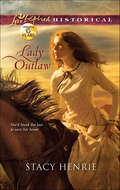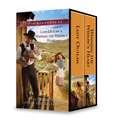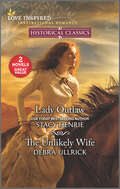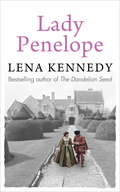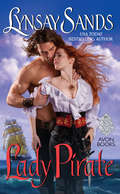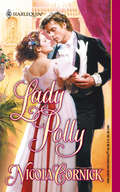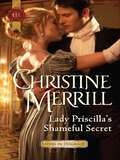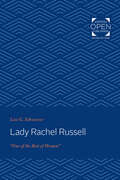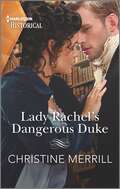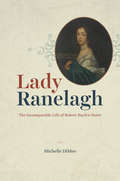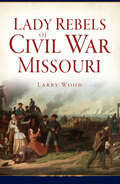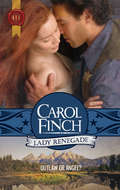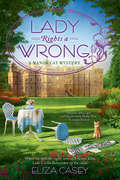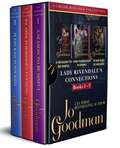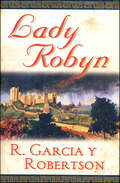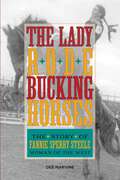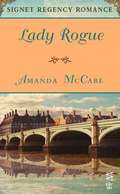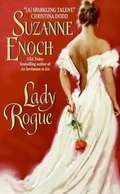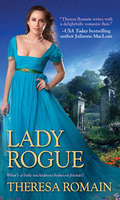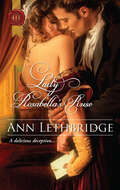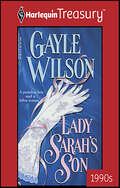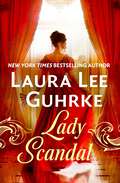- Table View
- List View
Lady Outlaw
by Stacy HenrieNo one would ever imagine a fresh-faced young woman could be robbing stage bandits of their ill-gotten fortunes. But Jennie Jones is desperate to save her family's ranch from foreclosure. And the risks seem worth it, until her upright new ranch hand offers a glimpse of how much is really at stake.Former bounty hunter Caleb Johnson is ready for a new, clean start. With a woman like Jennie, he could build a future there in Utah territory. But only if his gentle faith can guide her in a choice between the land she's fought so hard to save and a future by his side.
Lady Outlaw & Winning the Widow's Heart: Lady Outlaw\Winning the Widow's Heart
by Sherri Shackelford Stacy HenrieFall in love with these heartwarming classic Western historical romances by USA TODAY Bestselling Author Stacy Henrie and fan favorite Sherri Shackelford!Lady Outlaw by Stacy HenrieNo one would ever imagine a fresh-faced young woman could be robbing stage bandits of their ill-gotten fortunes. But Jennie Jones is desperate to save her family’s ranch from foreclosure. And the risks seem worth it, until her upright new ranch hand offers a glimpse of how much is really at stake.Former bounty hunter Caleb Johnson is ready for a new, clean start. With a woman like Jennie, he could build that future here in Utah territory. But only if his gentle faith can guide her in a choice between the land she’s fought so hard to save, and a future by his side.Winning the Widow’s Heart by Sherri ShackelfordWhen Texas Ranger Jack Elder stormed the isolated Kansas homestead, he expected to find a band of outlaws. Instead, the only occupant is a heavily pregnant woman—and she’s just gone in to labor. A loner uneasy with emotion, Jack helps deliver widow Elizabeth Cole’s baby girl and can’t get back on the trail fast enough. The robber and murderer he’s after killed one of Jack’s own—and he vows to catch the man. But when he returns to check on Elizabeth and her little one, he discovers that she may hold the key to his unsettled past—and his hoped-for future.
Lady Outlaw and The Unlikely Wife
by Debra Ullrick Stacy HenrieTwo most surprising women…Lady Outlaw by Stacy HenrieNo one would ever imagine that a fresh-faced young woman could be robbing stage bandits of their ill-gotten fortunes. But Jennie Jones is desperate to save her family’s ranch from foreclosure. And the risks seem worth it. Until her upright new ranch hand, former bounty hunter Caleb Johnson, offers a glimpse of how much is really at stake…The Unlikely Wife by Debra UllrickRancher Michael Bowen’s bride, married by proxy, is not what he expected. With her trousers, cowboy hat and rifle, Selina Farleigh Bowen looks like a female outlaw, not the genteel lady he corresponded with. Selina loved Michael’s letters, even if she couldn’t read them herself. A friend read them to her and wrote her replies—but that “friend” left things out. Yet time might show Michael the true value of his unlikely wife.USA TODAY Bestselling Author
Lady Penelope: A tale of romance and intrigue in Queen Elizabeth's court
by Lena KennedyA gripping story of romance, lovers and a life filled with intrigue . . .Warm-hearted and wilful, her temper as fiery as her beautiful auburn hair, Lady Penelope is a romantic heroine whose impulsive nature makes her as many enemies as her vivacious, flame-haired beauty wins her admirers.Caught up in the dangerous intrigues of Queen Elizabeth's court, forced to marry a wealthy but repulsive nobleman, she pours all her passion into her children . . . and her lovers. Will Penelope survive her loveless marriage and a life filled with tragedy, and finally emerge triumphant?******************What readers are saying about LADY PENELOPE'Perfect!' - 5 STARS'My favourite novel' - 5 STARS'I love the history behind the book' - 5 STARS'Loved it . . . Penelope was a brilliant character' - 5 STARS'Good from start to end' - 5 STARS
Lady Penelope: A tale of romance and intrigue in Queen Elizabeth's court
by Lena KennedyWarm-hearted and wilful, her temper as fiery as her beautiful auburn hair, Lady Penelope is a romantic heroine whose impulsive nature makes her as many enemies as her vivacious, flame-haired beauty wins her admirers.Caught up in the dangerous intrigues of Queen Elizabeth's court, forced to marry a wealthy but repulsive nobleman, she pours all her passion into her children . . . and her lovers. But though her heart often rules her head, Penelope survives her loveless marriage and a life filled with tragedy to emerge triumphant.
Lady Pirate
by Lynsay SandsOut of the frying pan...Circumstances had changed; they had gotten worse. Valoree no longer had to masquerade as her murdered brother and scourge the oceans as Captain Red. She no longer had to command his pirate band in a quest to regain his birthright. She had been named heir to Ainsly Castle. But no executor would ever hand over the estate to an unmarried pirate wench and her infamous crew--no matter to whom she'd been born. And the will had distinctly stated that in order to inherit, Valoree must be married to a nobleman...and pregnant.Into the fire...Upon learning that, the virgin captain had been ready to return to the seas, bur her crew had put it to a vote--and for those rascally cusses she would do anything. Reluctantly, she agreed. If they could find a way--Henry and One-Eye and Slully--to put on her a sweet face that would fool the ton, she would handle the rest. Even with a drunken prostitute as an "aunt" and her merry cutthroat crew as "servants." But to herself she swore one thing: she could only marry a man who fired her blood, a man who was not afraid of a ...Lady Pirate.
Lady Polly
by Nicola CornickEven as Lady Polly rejected another proposal of marriage, her heart burned for the man she'd rejected five years ago. She'd heard that in his misery, her beloved Lord Henry Marchnight had become a rogue and a gambler. But when he appeared before her on a deserted terrace and stole a kiss, Polly knew that her passion hadn't died. The man still knew how to steal her reason with one touch. But reason she needed as suspicions of criminal behavior hovered about Lord Henry. Should she return to her routine of spurning suitors? Or should she do what she should have done five years ago--trust her love and follow her heart...?
Lady Priscilla's Shameful Secret (Ladies in Disgrace #1089)
by Christine MerrillOutspoken Lady Priscilla is the only woman in London brave enough not to simper at Robert Magson. As the Duke of Reighland, he needs a wife and this captivating woman would surely keep life interesting!Despite the obvious sexual attraction between them, Lady Priscilla doesn't wish to marry-ever-for she hides a shameful secret. Surely a duke deserves more than a ruined woman? But once Robert sets his sights on something beautiful, he will do anything in his power to claim it!
Lady Rachel Russell: "One of the Best of Women"
by Lois G. SchwoererOriginally published in 1987. Lady Rachel Russell (1637–1723) was regarded as "one of the best women" by many of the most powerful people of her time. Wife of Lord William Russell, the prominent Whig opponent of King Charles II who was executed for treason in 1683, Lady Russell emerged as a political figure in her own right during the Glorious Revolution and throughout her forty-year widowhood. Award-winning historian Lois G. Schwoerer has written a biography that illuminates both the political life and the lives of women in late Stuart England. Lady Russell's interest in politics and religion blossomed during her marriage to Lord Russell and after his death: "as William became a Whig martyr, Rachel became a Whig saint." Her wealth, contacts, and role as her husband's surrogate gave her considerable influence to intercede in high government appointments, lend support in elections, and exchange favors with her friend Mary of Orange. In her domestic life she similarly took steps usually reserved to men, managing large estates in London and Hampshire and negotiating favorable marriage contracts for each of her three children. Although Lady Russell was unusual for her time, she was by no means unique. Other notable women shared her concerns and traits, although to differing degrees and effects. Schwoerer suggests that the horizons of women's lives in the seventeenth century may have extended farther than is often supposed.
Lady Rachel's Dangerous Duke (Secrets of the Duke's Family #3)
by Christine MerrillA sexy, thrilling Regency with a dash of mystery…The most notorious gentlemanIs the only man she wants… Everyone has heard the whispers about the Duke of Scofield: that he killed his own father! But Lady Rachel knows he&’s innocent, because she was with him that fateful night. He&’s too honorable to clear his name by ruining her, but why has he cut her out of his life? Rachel must discover the whole truth if she&’s to have any chance of being with him…From Harlequin Historical: Your romantic escape to the past.Secrets of the Duke's FamilyBook 1: Lady Margaret's Mystery GentlemanBook 2: Lady Olivia's Forbidden ProtectorBook 3: Lady Rachel's Dangerous Duke
Lady Ranelagh: The Incomparable Life of Robert Boyle's Sister (Synthesis)
by Michelle DiMeoFor centuries, historians have speculated about the life of Katherine Jones, Lady Ranelagh. Dominant depictions show her either as a maternal figure to her younger brother Robert Boyle, one of the most significant scientists of his day, or as a patroness of the European correspondence network now known as the Hartlib circle—but neither portrait captures the depth of her intellect or the range of her knowledge and influence. Philosophers, mathematicians, politicians, and religious authorities sought her opinion on everything from decimalizing the currency to producing Hebrew grammars. She practiced medicine alongside distinguished male physicians, treating some of the most elite patients in London. Her medical recipes, political commentaries, and testimony concerning the philosophers’ stone gained international circulation. She was an important influence on Boyle and a formidable thinker in her own right. Drawing from a wealth of new archival sources, Michelle DiMeo fills out Lady Ranelagh’s legacy in the context of a historically sensitive and nuanced interpretation of gender, science, and religion. The book re-creates the intellectual life of one of the most respected and influential women in seventeenth-century Europe, revealing how she managed to gain the admiration of diverse contemporaries, effect social change, and shape contemporary science.
Lady Rebels of Civil War Missouri (Civil War Series)
by Larry WoodWomen at WarAlthough war was traditionally the purview of men, the realities of America's Civil War often brought women into the conflict. They served as nurses, sutlers, and washerwomen. Some even disguised themselves as men and joined the fight on the battlefield. In the border state of Missouri, where Southern sympathies ran deep, women sometimes clashed with occupying Union forces because of illegal, covert activities like spying, smuggling, and delivering mail. When caught and arrested, the women were often imprisoned or banished from the state. In at least a couple of cases, they were even sentenced to death. Join award-winning author Larry Wood as he chronicles the misadventures and ordeals of the lady rebels of Missouri.
Lady Renegade
by Carol FinchU. S. Deputy Marshal Gideon Fox's first glimpse of the ravishing beauty was like a mystical vision. But when Lorelei Russell identified herself, the lawman in Gideon kicked in-this woman was wanted for murder! He'd have to tame his fierce attraction until justice could be served. For her part, Lori couldn't believe theinjusticeof it all. Falsely accused, apprehended by a hard-hearted marshal and, the most unfair part-how her body rebelled every time Gideon was near, making resistance to her gorgeous captor absolutely futile....
Lady Rights a Wrong (Manor Cat Mystery #2)
by Eliza CaseyAs the suffragette movement sweeps England in 1912, Lady Cecilia Bates wants to march but ends up trailing a killer instead in the latest entry to the Manor Cat Mysteries. Lady Cecilia of Danby Hall feels adrift. She couldn&’t be less interested in helping to plan the church's upcoming bazaar. Instead, what excites her most is the Woman&’s Suffrage Union meeting she has just attended. Inspired by the famous and charismatic leader of the group, Mrs. Amelia Price, Cecilia is eager to join the Union—if she can hide it from her parents, that is. But when Mrs. Price is found dead at the foot of the stairs of her home, her Votes for Women sash torn away, Cecilia knows she must attend to a more urgent matter: finding the killer. With the help of her lady&’s maid Jane and intelligent cat Jack, she hopes to play her part in earning women&’s equality by stopping the Union&’s dangerous foe.
Lady Rivendale's Connections Box Set, Books 1 to 3: Three Full-Length Historical Romance Novels
by Jo GoodmanDiscover Shadows of Desire amid Secrets Revealed in Lady Rivendale’s Connections Box Set, Books 1 to 3: Three Full-Length Historical Romances from Jo GoodmanBook 1 - A Season to be Sinful:Fleeing the grasp of an unwanted English lord, Lily Sterling—an orphan raised in a French abbey—seeks refuge in London's bustling streets, only to be ensnared by the very man she aimed to escape. Amidst her escape into Holborn's dangerous alleys, she becomes a guardian to young pickpockets, schooling them in survival when she valiantly rescues Alexander Grantham, Viscount Sheridan (Sherry), a man of uprightness attacked in the streets. In her brave attempt to save him, she's grievously wounded, leading Sherry to bring her and her charges under his care. As they recover, an undeniable attraction blossoms, unearthing deep-seated secrets and vulnerabilities. The discovery of their pasts' dangerous intertwining, coupled with Sherry's mysterious resignation from covert Crown work, propels them into a shared fight against a looming threat. In each other, they find not only love but the courage to face their shared enemy.Book 2 - One Forbidden Evening:Tormented by her husband's death and torn between motherhood and her desires, Cybelline Caldwell finds solace in the arms of Christopher Hollings, Earl of Ferrin, during a masquerade ball's night of passion. Their encounter, meant to remain anonymous, takes a turn when Ferrin vows to discover the identity of his mysterious lover. As he uncovers Cybelline's true self, she struggles with mysterious letters accusing her of her husband's murder, forcing her to flee London with her daughter to escape the allegations. Ferrin's quest to protect and understand Cybelline brings him closer to her family, winning her daughter's affection and gradually earning Cybelline's trust. Despite the looming threat of the letters' contents, their burgeoning relationship faces the ultimate test as they risk everything for love amidst shadows of suspicion and danger.Book 3 - If His Kiss is Wicked:After a harrowing abduction leaves Emmalyn Hathaway with fragmented memories and deep mistrust, she finds refuge in Restell Gardner, a man rumored to be both a rake and a savior. Amidst her turmoil, Emmalyn, alongside her cousin Marisol, seeks Restell's protection and expertise in navigating the treacherous undercurrents of her past. Restell, intrigued by Emmalyn's resilience and mystery, commits to unraveling the circumstances of her ordeal. Their investigation unveils a sinister realm of art fraud involving Marisol's fiancé, Neven Charters, an art expert, and the acclaimed artist Sir Arthur Vega, revealing secrets that threaten Emmalyn's fragile world. As danger mounts, Restell's resolve to protect Emmalyn evolves into a deeper, unexpected desire to win her heart, challenging him to not only safeguard her life but also to mend the trust and affection shattered by her trauma.Awards:Top Ten Best Romances 2018 Library JournalBest Romance, All About Romance 2008 Annual Reader PollRomantic Times Career Achievement AwardTop Ten Romance of the Year 2011, Library Journal#5 in the Top 100 Romances of All Time, Dear AuthorStarred reviews, Publishers WeeklyReviews:“A romance to savor.” ~Library Journal“Goodman has a real flair…Witty dialogue, first-rate narrative prose, and clever plotting.” ~Publishers Weekly“A master storyteller” ~The Romance Dish“Jo Goodman is a master at historical romance.” ~Fresh FictionLADY RIVENDALE'S CONNECTIONS, in series order:A Season to be SinfulOne Forbidden EveningIf His Kiss is WickedThe Price of Desire THE DENNEHY SISTERS SERIES, in series order:Only My LoveMy Heart's DesireForever in My HeartAlways in My DreamsOnly in My ArmsTHE MARSHALL BROTHERS SERIES, in series order:Her Defiant HeartHis Heart's RevengeTHE THORNE BROTHERS TRILOGY, in series order:My Steadfas
Lady Robyn (War of the Roses #2)
by R. Garcia y RobertsonThe author of two highly praised novels, The Spiral Dance and American Woman, R. Garcia y Robertson returns with a charming time-travel romance sequence. In Knight Errant, Robyn Stafford, a young American woman hiking in England near the Welsh border, was swept back in time to the 1460s, the age of the War of the Roses. There she fell in love with a young knight, Edward, son of the Duke of York. Cast back in time by witchcraft, Robyn, a young executive from Hollywood, raised in Montana, has chosen to stay there out of love for Edward, who has promised to marry her.Now in Lady Robyn, Robyn's fantasy of courtly romance comes up against the brute reality of medieval politics: the politics of murder, warfare, and betrayal. The War of the Roses is no longer a textbook subject, it's messing up her life, and so is the noble witch who, though he doesn't know it, is Edward's enemy. Edward's father, Richard, is making a bid for the throne, and if he wins it, Edward will be heir apparent. And if Robyn marries him, she will someday be queen and her children heirs to the throne as well. In the 1460s, that means living with the constant threat of death. The survival rate for heirs is not high. Will Robyn reject her love or risk the lives of her children to be?This is an engrossing time-travel romance in the mold of Diana Gabaldon's bestselling timeslip tales.At the Publisher's request, this title is being sold without Digital Rights Management Software (DRM) applied.
Lady Rode Bucking Horses: The Story of Fannie Sperry Steele, Woman of the West
by Dee MarvineThe Lady Rode Bucking Horses depicts an era of the American West when capturing renegade horses from the hills above the homestead served as training ground for extraordinary horsemanship. It documents the life of the outstanding girl who outrode them all at stampedes and roundups and the woman she became, her spirit undaunted throughout a life marked with courage and adventure, triumph and heartache.Born on a Montana homestead in 1887, at the age of two, Fannie Sperry declared "I gonna catch me a white-face horsie." A remarkable woman who became a world champion, she raced thoroughbreds with a women's relay team known as the Montana Girls, twice won the title of Lady Bucking Horse Champion of the World, rode with Buffalo Bill Cody and other top western performers, became the first woman in the state of Montana to be granted an outfitters license, and was named a charter member of the Cowboy Hall of Fame.
Lady Rogue
by Amanda MccabeTogether for the first time, two of Amanda McCabe's most captivating regency classics. . . Lady Rogue and The Star of India In Lady Rogue, Georgina Beaumont is a fiery spirit who believes that she doesn't need a man to make her happy. For Alexander Kenton, the Duke of Wayland, this is startling news since he's fallen for Georgina, and needs her hand to regain his place in society, if she'll take it. . . The Star of India is a jewel that's been kept with Lady Emily Kenton since her childhood friend, the Earl of Darlinghurst, left for India at age eight. Will the longing they've harbored for all these years fall to ruin when he learns of the terrible secret she bears regarding the jewels? .
Lady Rogue
by Suzanne EnochDear Reader, Some people grow up wanting to be lion tamers or astronauts. I've always wanted to be a writer. One day, during a slow afternoon at my day job, I thought: What would I write? Inspiration struck . . . an earl who fell in love with a spy! And thus Lady Rogue was born. Christine "Kit" Brantley is masquerading as a boy because her mission is to spy on Alexander Cale, the Earl of Everton. It doesn't take long for Alex to see through her disguise. Who would mistake this enchanting, albeit cheeky, chit for a lad? Alex is determined to discover the real reason Kit is in London, but as he's dragged into one escapade after another, he finds himself succumbing to her charm and spirit. I love this book, and I love the new package. In my mind it's a depiction of the first time Kit puts on a ball gown, and the way Alex Cale feels when he first sees her as a lady . . . Ah, me, now I'm getting sentimental. Enjoy! Suzanne Enoch P.S. Oh, and Lady Rogue also marks the debut of Mr. Francis Henning, who's made an appearance in every historical I've written since.
Lady Rogue (Royal Rewards #3)
by Theresa RomainHER SECRET SCANDAL As far as London’s high society knows, Lady Isabel Morrow is above reproach. But the truth is rarely so simple. Though the young widow’s passionate fling with dashing Bow Street Runner Callum Jenks ended amicably months ago, she now needs his expertise. It seems Isabel’s late husband, a respected art dealer, was peddling forgeries. If those misdeeds are revealed, the marriage prospects of his younger cousin— now Isabel’s ward—will be ruined. For the second time, Isabel has upended Callum’s well-ordered world. He’s resolved to help her secretly replace the forgeries with the real masterpieces, as a . . . friend. A proper sort of friend doesn’t burn with desire, of course, or steal kisses on twilight errands. Or draw a willing lady into one passionate encounter after another. Isabel’s scheme is testing Callum’s heart as well as his loyalties. But with pleasure so intoxicating, the real crime would be to resist . . . “Richly rewarding.” —Booklist, Starred Review on Fortune Favors the Wicked
Lady Rosabella's Ruse (Rakes And Rascals Ser. #2)
by Ann LethbridgeA rakish baron may provide a scandalous solution for a young widow in search of an inheritance in this sexy Georgian Era romance.When Garth Evernden, eighth Baron Stanford, attends an “anything goes” house party, none of the women in attendance catch his jaded eye. The only one worth noting is a covered-up lady’s companion with an intriguing hint of exotic beauty the baron would like to uncover . . .Rose is in fact posing as a widow to find her inheritance—without it, she and her sisters will surely perish. Knowing that the handsome baron is reputed for his generosity, Rose concocts a new solution to her pressing dilemma. Surely becoming mistress to this rake would bring material advantages . . .
Lady Sackville: A Biography
by Susan Mary Alsop[from inside flaps] ""Quel roman est ma vie!" was one of Lady Victoria Sackville's frequent exclamations. The accuracy of the phrase--had she been able to see her life story written out as it is in this charming and delightful biography--would have pleased her and doubtless prompted the observation yet again, "My life is just like a novel!" And few upper-class young Englishwomen have ever had more reason to say so. Born in 1862, she was the illegitimate daughter of Pépita, the Spanish dancer, and Lionel Sackville-West, the distinguished British diplomat. Part of the fascination of her story is how that irregular birth affected her life and how she learned to triumph over its liabilities and skillfully manipulate its assets to her advantage. "It was," as Nigel Nicolson (Victoria's grandson) says, "an astonishing life." Her father was named British Minister to the United States, and as his hostess Victoria became the most popular girl in the American capital. As wife of her cousin, also named Lionel Sackville-West, she became mistress of Knole, one of the largest of the stately homes of England. As a high-living adventuress, she was the object of two bizarre lawsuits, one of them to prove her illegitimacy--ironically thereby preserving Knole and the Sackville title for her husband. She enchanted the major artistic and political figures of her time, and her story will fascinate readers today as her personality fascinated, and sometimes shocked, her own generation. This biography completes a trilogy, begun by Vita Sackville-West's Pépita (the life of her grandmother, the Spanish dancer) and continued by Portrait of a Marriage, in which Nigel Nicolson re-created the story of his parents, Vita and Harold Nicolson. Lady Sackville bridges the space between those two books, one by her daughter, the other by her grandson, to complete the picture of three generations of an ancient, noble, and gifted family. Susan Mary Alsop's previous book was To Marietta from Paris. Mrs. Alsop lives in Washington D.C."
Lady Sarah's Sinful Desires: Secrets at Thorncliff Manor (Secrets At Thorncliff Manor Ser.)
by Sophie BarnesThe USA Today–bestselling author welcomes you to Thorncliff Manor, where London’s elite mix, mingle, and may even find their heart’s desire . . .There are thousands of things Christopher, Viscount Spencer, would rather do than hunt for a bride, especially since experience has taught him that women are not to be trusted. Then he finds the intriguing Lady Sarah scrambling around in Thorncliff’s conservatory and he is instantly charmed by her passionate nature. But why is she so intent on avoiding him?Lady Sarah would make the perfect bride for a peer—if not for a tarnished past that she’s hiding from the ton. A stay at Thorncliff Manor was meant to help her plan for her future, not fall in love. Yet Christopher’s kisses are irresistible, his gallantry enticing. When her secret stands to be revealed, will the truth ruin their dreams of happiness?
Lady Sarah's Son
by Gayle WilsonJustin Tolbert was a war hero and the new Earl of Wynfield, but he was not the same man Lady Sarah Spense once knew....Suddenly, too vividly, Sarah remembered the night he had first asked her to dance. The London ballroom had been overcrowded, its heat stifling. Justin had been wearing his uniform, the handsome regimentals setting off the perfection of his strong body and his still-boyish face. She had thought then that there was no man more handsome in the room. She had stepped willingly into his arms, and when the music had begun, she had drifted, following his lead. They had moved together without conscious thought. As if the two of them had been created to dance together....Would they ever do that again...?Don't miss Gayle Wilson's extraordinary tale!
Lady Scandal (Scandal at the Savoy)
by Laura Lee GuhrkeFrom a New York Times bestselling author comes a dazzling Victorian romance featuring a haughty businessman and the headstrong event planner who steals his heart—perfect for fans of Bridgerton, Evie Dunmore, and Amalie Howard! Delia Stratham is an unconventional woman. While other ladies learned proper decorum at finishing school, she composed naughty limericks and admired the gardener&’s muscular legs. So naturally when she&’s widowed for the third time, she does the unthinkable: she gets a job. Planning events for the Savoy Hotel is perfect for someone with her skills. But her dream career turns into a nightmare when she&’s forced to work with the most annoying—and gorgeous—man she&’s ever met. Hotel magnate Simon Hayden knows something fishy is going on at the Savoy: the hotel is constantly busy, yet the books say it&’s in the red. He&’s determined to root out the fraud and its perpetrators, and that means spending time with one of the most likely suspects: the delectable, infuriating Lady Stratham. She&’s definitely getting in his way and under his skin and he can&’t decide whether to fire her or kiss her until she stops arguing. But when the sparks between them flare into flame, Simon must choose between his love for Delia and his duty to the hotel. Will his choice bring them together or tear them apart?
